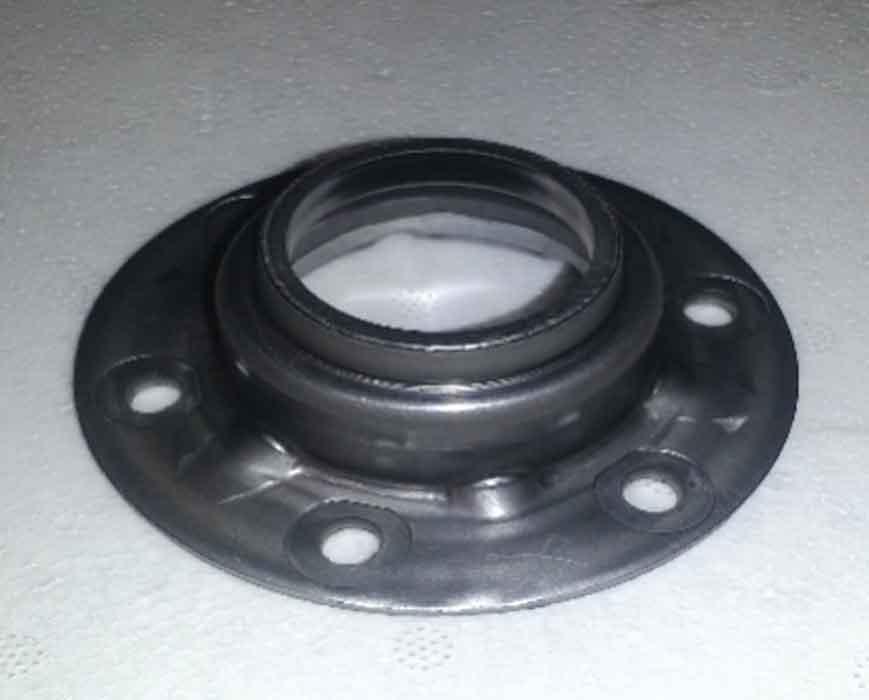Sales & Marketing Manager
- FMA
- The Fabricator
- FABTECH
- Canadian Metalworking
Categories
- Additive Manufacturing
- Aluminum Welding
- Arc Welding
- Assembly and Joining
- Automation and Robotics
- Bending and Forming
- Consumables
- Cutting and Weld Prep
- Electric Vehicles
- En Español
- Finishing
- Hydroforming
- Laser Cutting
- Laser Welding
- Machining
- Manufacturing Software
- Materials Handling
- Metals/Materials
- Oxyfuel Cutting
- Plasma Cutting
- Power Tools
- Punching and Other Holemaking
- Roll Forming
- Safety
- Sawing
- Shearing
- Shop Management
- Testing and Measuring
- Tube and Pipe Fabrication
- Tube and Pipe Production
- Waterjet Cutting
Industry Directory
Webcasts
Podcasts
FAB 40
Advertise
Subscribe
Account Login
Search
Next-gen stamping lubricants advance health, safety, environmental goals
Can stampers meet HSE requirements without diminishing performance, rising costs?
- By Chris Fletcher
- August 6, 2020
- Article
- Safety

In today’s health-conscious age, it’s good to know that stamping lubricants focused on health, safety, and environment (HSE) work without diminishing performance and rising costs. Getty Images
Health and safety have been of primary concern in 2020 for obvious reasons. COVID-19 and the resulting “new normal” have brought a new appreciation for living and breathing.
As stamping manufacturers progress through this pandemic and beyond, there has been a rejuvenated focus on health and safety. And why not? Isn’t keeping everyone safe and healthy a primary focus of any company? Channeling that motivation can help metal formers improve the health, safety, and environmental (HSE) aspects of their processes by the lubricants they use.
Lubricants and Performance, Tool Life, Cost
There are many facets to metal forming lubrication, including operational hazards, performance, tool life, cleaning operations, disposal, and, of course, cost. Questions arise—especially in today’s health-conscious climate, about safety and performance in operations involving lubrication. Can lubricants be safer without diminishing performance and rising costs? Are HSE alternatives applicable for the growing use of aluminum and new high-strength steels?
The answers to all of these are yes. Following are some examples of ways to introduce HSE lubricants without losing performance.
Vanishing Oils and VOCs
Many stamping operations still use solvent-based vanishing oils. They are the standard for a clean part, no residue, no stickiness in the die, and perhaps a dry part going into a finished container. The caveat is that these products contain a volatile organic compound (VOC), which is hazardous to operators and the environment.
Reducing and eliminating VOCs in a process by substituting them with non-VOC products has been a goal of many shops over the years. In some cases, a lubricant that can be diluted with water can be used. However, typical dilutions cannot meet all requirements of the process, such as dry parts, no residue, and optimal performance.
However, several stampers are using a non-VOC, undiluted vanishing lubricant designed to dry just as fast as a solvent-based vanishing oil and leave little or no residue on the part. This eliminates the hazardous component while still meeting the fundamental needs of the process. Special consideration is given to the entire process, including stamping performance, flat stacking of parts (when applicable), and dwell time from production to use.
Hazardous Versus Nonhazardous: A One-for-One Switch
Another case of a hazardous operation involved a stamping company using a synthetic stamping lubricant to produce automotive stampings. The company launched an HSE initiative, which became more urgent when operators began experiencing dermatitis.
An investigation revealed that the lubricant had been identified as toxic on the SDS with an exploding heart pictogram and specific warnings of serious eye damage, carcinogenicity, and targeted organ failure with repeated exposure.
Switching to a next-generation, nonhazardous, pictogram-free synthetic lubricant reduced the toxicity exposure and eliminated the dermatitis immediately. The nontoxic lubricant also was able to improve performance by reducing tool wear and improving part quality without additional cost. Operators were very happy and appreciative that their health and safety were paramount in this decision.

A stamping manufacturer switched from using a VOC-containing vanishing oil on a finished cargo restraint device to a VOC-free, HSE-safe lubricant in its stamping process.
Performance and Chlorinated Paraffins
In the past many safer fluids meant a loss of performance and a higher cost. Today that’s not the case. Newer technology and additives are safer than ever before. They are highly engineered to maintain performance. Yes, generally, there is a cost to doing so. But the value in increased performance and safety that these products provide usually justifies the initial cost increase and decreases overall process costs.
One such replacement is the elimination of a chlorinated paraffin (CP) straight or soluble oil with a chlorine-free soluble oil. It was once thought impossible to eliminate CPs and attain good performance. The prevailing opinion was that soluble oils had to contain very large amounts of CP and other, more toxic ingredients to keep up good performance. That increased risks to the HSE.
CPs have been a major topic of conversation for many years. The EPA has targeted medium-chain chlorinated paraffins (MCCP) and long-chain chlorinated paraffins (LCCP), barring the manufacture and use of them because of their persistent bioaccumulation in the environment. That initiative was put on a five-year hold to gather more data and validity to the claim, but it will certainly be discussed and pursued again soon.
However, even in the initial claim, the EPA stated that very long-chain chlorinated paraffins (vLCCP) did not have the same bioaccumulation properties. Therefore, they were given a Chemical Abstracts Service registry number, permitting them to be produced, and are being used in metalworking fluids today instead of the medium- and long-chain versions.
The use of vLCCPs is one step in the right direction of improving HSE, but that’s not stopping manufacturers from seeking newer and environmentally safer alternatives so that CPs can be eliminated from metalworking fluids altogether. It is a tough task; the extreme-pressure and barrier additives have been used for decades because of their ability to cover the temperature gradient most stamping processes operate in. Today this goal can be met in many processes and varied materials.
Chlorine-free Fluid on Steel
A stamping company was able to match the performance of a CP straight oil on a 4-mm-thick, heavy-gauge-steel bearing hub using a vLCCP soluble oil. The goal was simply to reduce cost through dilution, be CP-compliant in the future, and maintain performance. At a 4-to-1 dilution, that goal was met.
Fast-forward. Today’s next-generation lubricants are furthering those endeavors with chlorine-free soluble oils. Initial friction, bench scale, and field tests revealed that this newer technology’s performance was comparable to the tried-and-true CP soluble oil.
The use of chlorine-free soluble oils on the same heavy-gauge-steel bearing hub netted a better result than the company had originally anticipated. Because the new alternative product was already chlorine-free and hazard-free, the company set new goals to further reduce its impact on HSE and improve overall rust protection on stored parts. Goals accomplished.
In addition, a matching 4-to-1 dilution allowed the stamper to extend the number of runs with less galling and reduced part temperatures—which in turn decreased tool wear and downtime. Continuous improvement of HSE and performance led to a 20% overall cost reduction on the manufacture of that part.
Cleanability and Aluminum
In a similar case involving a straight oil and a deep-drawn, 0.055-in.-thick 5XXX series aluminum housing, a stamper was trying to reduce splitting and cracking while improving the cleanability of the parts using a soluble oil. Even though the parts underwent an aggressive washing process, the company still had not been able to produce the desired level of cleanliness with a higher-performing straight oil.

Chlorinated paraffins, an ingredient in straight, soluble, and vanishing fluids, have been targeted because of their accumulated effect and some harm fish, animals, humans, and the environment. Image courtesy of fuelsandlubes.com
Previous lubricant trials had shown that while many soluble oil alternatives met the cleanability goal at a higher dilution, they didn’t exceed or even match the performance of the straight oil.
The introduction of a different HSE-focused, next-generation soluble oil at a 4-to-1 dilution eliminated splitting in the process and achieved the desired cleaning specification.
As a bonus, using the new lubricant reduced the volume needed and accompanying costs and eliminated clogged sprayer nozzles. Of course, it offered a better HSE condition for the company and its employees.
Matching Extreme-pressure Characteristics on AHSS, UHSS
Similar focus can be applied to tribulations used to form advanced high-strength steels (AHSS) and stainless steels. In fact, many of these newer fluids are taking the lead on formability. Armed with state-of-the-art additives that are conducive to the higher temperatures and friction that these materials generate, new soluble oils and synthetics continue to provide good boundary lubrication as well as extreme-pressure characteristics.
Many stampers would like to use one lubricant on multiple substrates. In one case, a manufacturer was stamping new automotive parts out of 0.100-in.-thick 5XXX series aluminum and medium-gauge 3XX series stainless steel. The CP soluble oil it was using on the aluminum created welding problems downstream. The medium-duty synthetic oil used on the stampings did not prevent scoring and tool wear on the stainless steel.
Both the CP soluble oil and medium-duty synthetic oil incurred process performance problems. One also had negative HSE implications. Because a safe synthetic was already being used on all the other stampings, an HSE-friendly soluble oil was chosen to help provide better lubricity to both substrates and to improve the process.
The next-generation slip, boundary, and extreme-pressure additives filled the performance gap on the stainless and provided extended dilution potential for the aluminum part to solve the downstream welding problems.
Most importantly, the company was able to solve its issues without relaxing its commitment to HSE safe lubricants.
Stay Safe in a Changing World
When trying to improve HSE in your processes, look at newer lubricant technologies that use state-of-the-art ingredients. These alternatives to older standards offer like performance. Look to eliminate solvents and CPs when possible.
New soluble oil and synthetic lubricant technologies can have a positive impact on the entire process by reducing HSE concerns for operator safety, cleanability, and compliant disposal. Look for pictogram-free products. Although metal forming processes will continue to change in today’s new normal, the heightened focus on safety should not. In the end, you may find that increasing your HSE may decrease your process costs.
Chris Fletcher is sales and marketing manager for Tower Metalworking Fluids.About the Author
Related Companies
subscribe now

The Fabricator is North America's leading magazine for the metal forming and fabricating industry. The magazine delivers the news, technical articles, and case histories that enable fabricators to do their jobs more efficiently. The Fabricator has served the industry since 1970.
start your free subscription- Stay connected from anywhere

Easily access valuable industry resources now with full access to the digital edition of The Fabricator.

Easily access valuable industry resources now with full access to the digital edition of The Welder.

Easily access valuable industry resources now with full access to the digital edition of The Tube and Pipe Journal.
- Podcasting
- Podcast:
- The Fabricator Podcast
- Published:
- 04/16/2024
- Running Time:
- 63:29
In this episode of The Fabricator Podcast, Caleb Chamberlain, co-founder and CEO of OSH Cut, discusses his company’s...
- Industry Events
16th Annual Safety Conference
- April 30 - May 1, 2024
- Elgin,
Pipe and Tube Conference
- May 21 - 22, 2024
- Omaha, NE
World-Class Roll Forming Workshop
- June 5 - 6, 2024
- Louisville, KY
Advanced Laser Application Workshop
- June 25 - 27, 2024
- Novi, MI
































